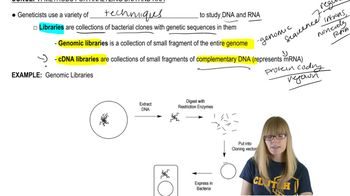Table of contents
- 1. Introduction to Genetics51m
- 2. Mendel's Laws of Inheritance3h 37m
- 3. Extensions to Mendelian Inheritance2h 41m
- 4. Genetic Mapping and Linkage2h 28m
- 5. Genetics of Bacteria and Viruses1h 21m
- 6. Chromosomal Variation1h 48m
- 7. DNA and Chromosome Structure56m
- 8. DNA Replication1h 10m
- 9. Mitosis and Meiosis1h 34m
- 10. Transcription1h 0m
- 11. Translation58m
- 12. Gene Regulation in Prokaryotes1h 19m
- 13. Gene Regulation in Eukaryotes44m
- 14. Genetic Control of Development44m
- 15. Genomes and Genomics1h 50m
- 16. Transposable Elements47m
- 17. Mutation, Repair, and Recombination1h 6m
- 18. Molecular Genetic Tools19m
- 19. Cancer Genetics29m
- 20. Quantitative Genetics1h 26m
- 21. Population Genetics50m
- 22. Evolutionary Genetics29m
18. Molecular Genetic Tools
Methods for Analyzing DNA
Problem 17a
Textbook Question
Textbook QuestionA hereditary disease is inherited as an autosomal recessive trait1. The wild-type allele of the disease gene produces a mature mRNA that is 1250 nucleotides (nt) long. Molecular analysis shows that the mature mRNA consists of four exons that measure 400 nt (exon 1), 320 nt (exon 2), 230 nt (exon 3), and 300 nt (exon 4). A mother and father with two healthy children and two children with the disease have northern blot analysis performed in a medical genetics laboratory. The results of the northern blot for each family member are shown here. Based on your analysis, what is the most likely molecular abnormality causing the disease allele?
 Verified Solution
Verified SolutionThis video solution was recommended by our tutors as helpful for the problem above
Video duration:
2mPlay a video:
Was this helpful?
Key Concepts
Here are the essential concepts you must grasp in order to answer the question correctly.
Autosomal Recessive Inheritance
Autosomal recessive inheritance refers to a pattern where two copies of a mutated gene, one from each parent, are necessary for an individual to express a hereditary disease. In this case, both parents can be carriers of the mutation without showing symptoms, which is why they have healthy children alongside affected ones. Understanding this concept is crucial for analyzing the inheritance pattern in the family described.
Recommended video:
Guided course

Autosomal Pedigrees
Mature mRNA Structure
Mature mRNA is the final product of gene expression, consisting of exons that have been spliced together after introns are removed. The total length of the mature mRNA is determined by the sum of the lengths of its exons. In this scenario, the mature mRNA is 1250 nucleotides long, and the specific lengths of the four exons provide insight into potential mutations that could affect mRNA processing or stability, leading to the disease.
Recommended video:
Guided course

Ribosome Structure
Northern Blot Analysis
Northern blot analysis is a technique used to detect specific RNA sequences in a sample. It allows researchers to assess the expression levels of genes and identify any abnormalities in mRNA size or abundance. In the context of this question, the northern blot results for the family members can reveal whether the disease allele produces a defective mRNA, which is essential for determining the molecular basis of the hereditary disease.
Recommended video:
Guided course

Chi Square Analysis

 7:40m
7:40mWatch next
Master Methods for Analyzing DNA and RNA with a bite sized video explanation from Kylia Goodner
Start learningRelated Videos
Related Practice


